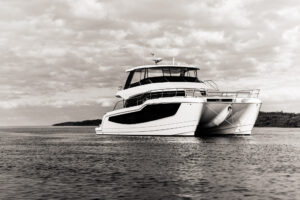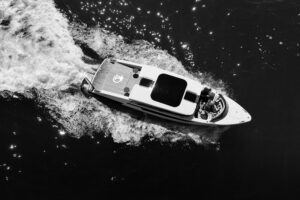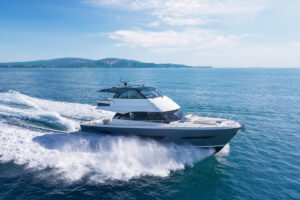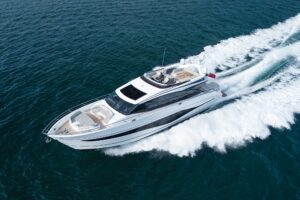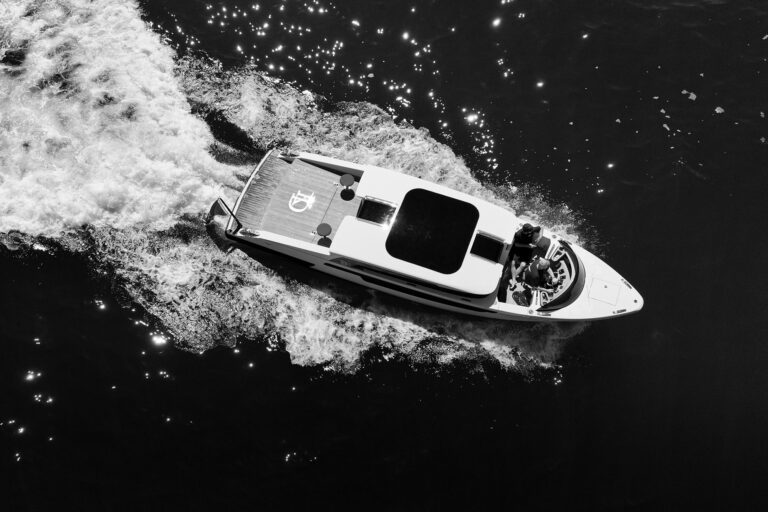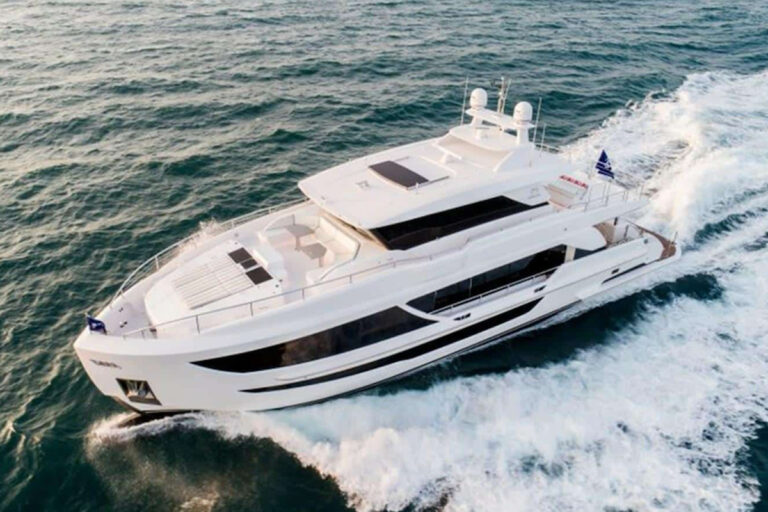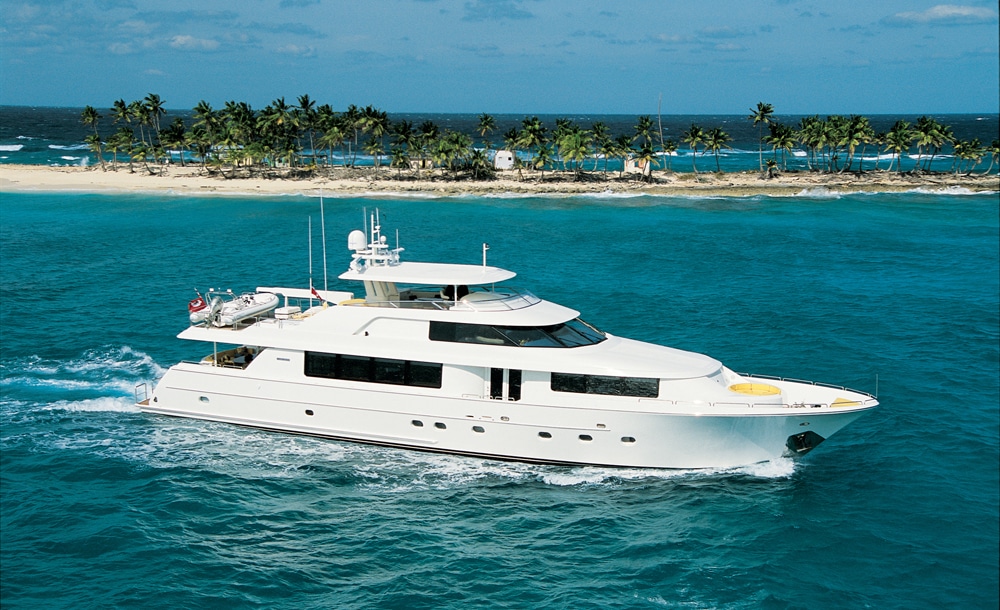
Westport 112
Few, if any, yacht designs have as long and interesting a timeline as the Westport 112 motoryacht. This model’s longevity is due entirely to its popularity with buyers, as evidenced by the 50 hulls built to date. Currently being delivered at the rate of three per year, there is no end in sight.
This level of long-term commercial success requires both new and repeat buyers. It’s not surprising that owners of smaller yachts, Westport and otherwise, would look to the 112 as their desires and resources grew. While that is the norm, one buyer taking delivery of a new 2012 model traded in his 1998 Westport 112.
Such an exchange indicates continuing satisfaction with the construction and functionality of the model; a cordial relationship with the builder and its after-sale support services; and a craving for the enhanced features available only on the newer version of the yacht. Among the most prominent of those elements is the newly optional arrangement featuring a main-deck master suite.
Phil Purcell, Westport’s longtime vice president of sales, says the new arrangement was proposed to reignite interest among buyers during the economic slump that first hit the marine industry in 2008. The layout was intended to appeal to Middle Eastern yachtsmen, and the first hull with an on-deck master was delivered to a client in Lebanon. Subsequent sales of the Westport 112, however, have been to North American buyers. Purcell is quick to point out that both of the arrangement plans are and will remain available, but he predicts that three out of four new builds will have the on-deck master stateroom.
_Click here to see a full photo gallery of the Westport 112._
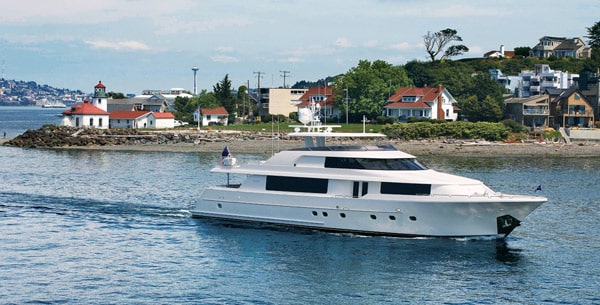
Purcell certainly knows his stuff when it comes to yachts and the buyers, but I’d bet his prediction will hold true only until Westport’s team of innovative designers, under the leadership of naval architect Taylor Olson and engineering coordinator Tom Fox, develops yet another incarnation of the venerable model. To understand just how Westport has arrived where it is today, let’s take a look at the origins and the journey of the yard and the Westport 112 from inception to the present.
Westport Shipyard was founded in 1964 in the southwestern Washington town of the same name. Initially, it focused on building vessels for the local commercial fishing industry, but word of the yard’s quality work soon spread and others came knocking. Brothers Rick and Randy Rust bought the shipyard in 1977. The Rusts brought a broader outlook to the company and soon added commercial passenger vessels to Westport’s portfolio.
An attractive pair of 92-foot passenger ferries serving California’s Catalina Island generated a ton of publicity for the yard, and their offshore performance brought inquiries for other applications. Having heavily invested in specialized equipment to speed the production and enhance the quality of fiberglass hulls, superstructures and other molded parts, Westport received orders from custom builders around the Pacific Northwest to supply their lamination needs.
The Rusts favored Seattle designer Jack Sarin, who had perfected his trade under the tutelage of the legendary Ed Monk Sr., working alongside Ed Monk Jr. The two younger men, today both in their 70s and with formidable reputations of their own, eventually set up separate design studios, Monk Jr. focusing on smaller yachts and commercial craft while Sarin tended to focus on larger vessels. Thus was the genesis of Golden Delicious, a 98-foot motoryacht designed by Sarin and built by Westport, which took the industry by storm in 1988. It was a particularly pretty boat with an excellent hull and, if not the largest, was certainly among the biggest fiberglass yachts built at that time. It formed the basis for the current Westport 98.
Over the years, the Rusts expanded their line of yachts to include the Westport 112, also based on a Sarin-designed hull. They would eventually sell the company, part at first and then all, to Orin Edson, an entrepreneur who had built an empire in production boatbuilding with the U.S. Marine Corp., located in northern Washington.
Edson brought in fresh ideas and fresh faces, hiring Daryl Wakefield as general manager and augmenting the design talents of Sarin with those of Bill Garden and Greg Marshall. Wakefield, in turn, hired Olson (who had worked with Sarin) and Fox (who had worked with Wakefield at Admiral Yachts) to implement the new order.
The most important of the changes were Edson-inspired procedures and controls, which enabled Westport to build custom yachts in an environment that is largely production-oriented. Such an approach ensures consistent quality while keeping costs in check, both of which significantly benefit the builder and buyer alike. Thus, Westport’s line of offerings is broad and diverse, but only specific lengths are available. Arrangement choices can be tweaked a bit, but the basic platform is fixed — bulkheads and stairways, for instance, cannot be moved. Propulsion packages change only to incorporate new technology. The Westport 112 has transitioned from Detroit 8V92s to Detroit 12V92s to MTU 396s to today’s pair of MTU 16V2000 engines, now driving custom propellers at lower shaft speeds for better efficiency and less vibration, whether at the yacht’s top speed of 25 knots or her cruise of 22 knots.
Such limitations don’t seem to be a hindrance to buyers of the 112, who are free to personalize their yachts with a wide choice of decor and other interior options, and now, a second arrangement plan. The classic edition includes a master, a VIP and two twin staterooms belowdecks, and a country kitchen forward on the main deck. This vessel’s new arrangement still has four guest staterooms below, although the fourth is now a small upper/lower rather than a king master suite. The master suite sits where the country kitchen once resided, all the way forward on the main deck, with a spacious head down a few steps under the foredecks, borrowing from the space formerly occupied by the below-deck master. Otherwise, much is the same in both versions, with a spacious salon, dining room, galley and open-yet-protected afterdeck on the main level, and with lots of open entertainment area topside and forward.
The Westport 112 still rides on the original Sarin-designed hull form, but credit for the modern profile and new arrangement goes to Taylor Olson. Purcell readily gives Olson his due, pointing out that he restyled not only the 112, but the 130 as well, to create a family look established by Marshall’s restyling of Westport’s 98. The multitalented Olson also collaborated with Garden on the hull for the Westport 164, which features exterior styling by Donald Starkey.
Although the 112 has a new exterior and a new arrangement, the builder’s attention to detail in construction and outfit, in joinery and systems, remains much as it has been since the beginning — the best it can be, and utterly complete on delivery. Westport’s reputation is so good that many buyers dispense with the traditional shakedown cruise, instead departing the yard and heading off on their maiden voyage, confident that their vessel will perform as promised.
LOA: 112’0′
Beam: 23’9″
Draft: 5’6″
Displ.: 236,000 lb.
Fuel: 5,500 gal.
Water: 1,012 gal.
Construction: Fiberglass
Design: Jack Sarin/Taylor Olson
Interior: Client’s choice
Generators: 2 x Northern Lights 65 kW
Stabilizers: Naiad 353
Bow Thruster: American 16″, 40 hp
Watermakers: 2 x Sea Recovery 1,400 gpd
Engines: 2 x 2,000 hp MTU 16V2000 diesels
Propellers: Michigan 5-blade, 48″
Speed: 25 knots max, 22 knots cruise
Base Price: $11,295,000
Westport Yachts, 954-316-6364; westportyachts.com

